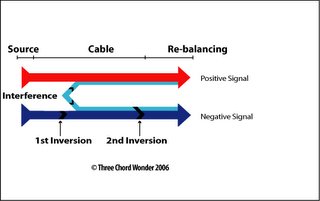DRAFT
Cables are the most likely point in a sound reinforcement system where interference can enter the signal path, and it's usually caused by RF (Radio Frequency) signals.
If I had a pound for the number of times I'd heard a radio station picked up by a guitar amp....I'd be able to employ someone to write this for me! I've even heard cinema soundtracks! (via Deaf Loops)
All because of the simple, and Unbalanced, cables that guitar's use. Though a guitar itself is shielded against interference (see the silver foil in a guitar's cavity) the guitar cable acts as an aerial!
So, What can we do?
I will look at cable itself in another article, but I need to explain this basic difference in cable types; audio interconnects have a shield or drain which wraps around the innercores of which there will be only one core for an unbalanced connection or two (or more) cores for a balanced connection. So, if a single connection can pickup analogue signals, such as radio waves, what does adding another core do?
OK, here's the technical bit. The single core in our unbalanced cable carries a positive signal. The extra core(s) in our balanced cable carries the same signal but inverted by 180 degrees. Let's not worry about how that's done for now, but what it mean is you have a positive signal and an exact copy of the that signal that's been reversed running down the same cable next to each other. This means that they will pick up the same interference at the same point and level. When they arrive at their destination, the negative signal is inverted another 180 degrees (back to where it started) and is added back to the positive signal. Relative to 0V, if one wire carries a positive voltage, then the other carries an equal and opposite negative voltage.
The result is that we have two things happening: you are adding a copy of the original signal to the actual original signal, therefore increasing the overall level but also adding a positive version of any interference to a negative version (from the inverted negative signal) which cancel each other out and should leave us with an interference free signal! See below for a further explanation:

The diagram shows the components of the signal and how they change from negative/positive.
It's based on the mathematical rule that: Negative + Negative = Positive, that's how the interference is cancelled out, importantly, WITHOUT affecting the tonal quality of the signal.
there a several ways of 'balancing' a signal like: Transformer Balancing, Electrically (Active) Balancing and 'Floating' Balancing. These use either solid state (such as a dynamic microphone like a sure SM58) to I.C.'s or 'Chips' (OP-Amps for those who are interested,) which
most rack processing gear will use.
In some cases, where the output of a device is actively balanced, converting from balanced to unbalanced without using a D.I. box, can cause a 6dB loss in signal level. Some devices will have a switch that changes the output level (in dB) to compensate for this, which will usually be marked as "+4" on one side and "-6" on the other. The values may be different, such as Behringer units which are usually "-10", but the idea is the same.
Given the choice then, and to keep the interference to a minimum, always use balanced cabling and convert unbalanced signals where possible when they are over 1m in length.
(FYI Humbucking pickups on electric guitars use exactly the same principle.)
No comments:
Post a Comment